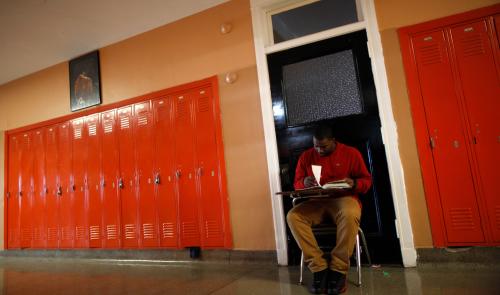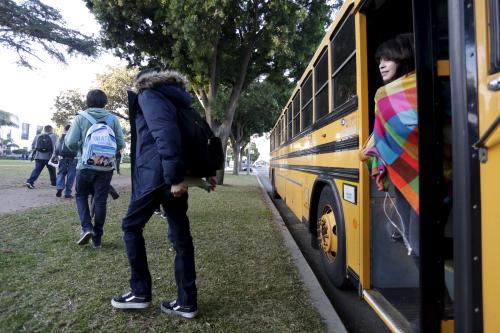This story about segregated schools was produced by The Hechinger Report, a nonprofit, independent news organization focused on inequality and innovation in education.
There’s an adage many researchers and policy wonks live by: What gets measured, gets done. The saying suggests that measuring something enhances your ability to achieve it—except, of course, when you’re talking about integrated schools. We’ve quantified, studied and assessed the importance of diversity in schools, but it’s something we haven’t come close to achieving.
While housing segregation strongly influences the composition of the student body, even in diverse cities, low-income black and brown students are increasingly becoming concentrated in certain schools. This is a result of middle-income, largely white families choosing to cluster (read: segregate) in middle- and upper-income schools and neighborhoods in their pursuit of a good education for their kids.
“Income segregation creates districts of concentrated poverty or affluence, but high-income black families may be less likely than high-income white families to live in the affluent districts created by income segregation,” according to 2018 research published by the American Sociological Association.
Given that students’ test scores rise in conjunction with how much money their parents make, a wealthy school with high test scores is too often automatically deemed “good.”
Herein lies the problem that thwarts efforts to find and create quality schools. Given that students’ test scores rise in conjunction with how much money their parents make, a wealthy school with high test scores is too often automatically deemed “good.” This assumption is not warranted: Wealthier families are putting more of their discretionary money into educational activities like test prep, which do increase students’ scores, but the wealth inflates what we believe teachers, curriculum, and culture from inside the school are adding to students’ academic growth. Schools are good when teachers bring the best out of their students—regardless of their economic backgrounds—with a rigorous curriculum and engaging arts and sports programs. By conflating test scores, and therefore income with quality, parents are justifying their desire to self-segregate as looking out for the interest of their children. But segregation is clearly not the way to create a good school.
Using standardized testing to measure academic achievement is one way to capture how good a school is, but differences in achievement that promulgate inequality are caused by segregation. Lifting test scores is far from the end goal we perceive it to be. Integration in schools and the workplace, social cohesion, and democratic decision-making are essential goals of a democracy that schools are supposed to encourage. Becoming more educated by being more segregated, which we seem quite comfortable with, should be avoided. Schools should be held accountable to higher-order democratic aims like integration rather than just pushing students to some level of academic progress.
New York City just took the first step in creating a robust accountability system that measures the right things. Last week, Mayor Bill de Blasio’s School Diversity Advisory Group, which is comprised of over 40 parents, advocates, students, teachers, and city government employees handpicked by City Hall, released its Making the Grade report, which offers a framework on how to make schools accountable to diversity and inclusion goals. The report offers evidence of what is anecdotally known: New York City schools are some of the most segregated in the country. The report recommends a framework for improvement to the mayor, who has the authority to take action. The proposed framework addresses the three problems that are keeping us from creating authentically good schools.
The report tackles the conflation of wealth and quality by recommending that all schools reflect the diversity of the city and borough they are in. The report asks that schools within each borough of New York City, which is a sub-district, develop student enrollment targets based on the percentages of racial and economic groups, language learners and students with disabilities within the district. The report also calls for the development of admissions criteria that hold schools accountable for realizing these socio-economic diversity goals. In doing so, the report’s authors are saying you can’t have quality without diversity. It doesn’t lay out specific admissions criteria, but if and when the mayor or his team proposes new admissions standards, such standards will almost certainly rile middle- and upper- income parents on the city’s Upper West Side.
Last year, footage of a heated school meeting by Spectrum News NY1 went viral. White parents expressed their disappointment and fury over a plan requiring all middle schools to keep aside a quarter of their seats for students who didn’t meet academic benchmarks as part of an effort to diversify the schools. In doing so, they revealed their racism: Wealthy, mostly white families complained the district was robbing their children of opportunities to learn.
“You’re talking about telling an 11-year-old, ‘You worked your butt off, and you didn’t get that, what you needed or wanted,’” said one woman. “You’re telling them ‘You’re going to go to a school that is not going to educate you in the same way you’ve been educated. Life sucks!’” New York’s education chancellor tweeted the story with the caption, “WATCH: Wealthy white Manhattan parents angrily rant against plan to bring more black kids to their schools.”
Segregated schools invariably lead to an uneven distribution of resources. Good schools support funding in diversity; they don’t discourage it. The report also addresses this central problem. The plan calls for making “resources available for any district to receive support for planning diversity.” It also recommends uplifting and supporting relationships between students, parents, teachers, guidance counselors, and other school staff, alongside a rigorous curriculum. The quality of these relationships tells more of the quality of a school than mere test scores. The report recommends that district leaders assess the school climate, including the roles and responsibilities of the school safety agents (aka police).
Diversity isn’t simply a student enrollment issue. Inclusion involves the school staff as well.
Diversity isn’t simply a student enrollment issue. Inclusion involves the school staff as well. Consequently, the report calls for diversity among “principals, teachers, paraprofessionals, and all other school staff.”
It’s past time districts introduce accountability goals that address the source of our educational problems: segregation. Housing segregation undoubtedly makes it difficult to create integrated schools. While it’s harder to change neighborhoods than to change schools, we can make sure that schools don’t replicate our segregated lifestyles. Diverse cities like New York offer an opportunity to create diverse schools—we should take it.
The old measurement adage—that what gets measured, gets done—doesn’t ring completely true. Measurement absent accountability won’t get you far, especially if you’re measuring the wrong thing. Strictly measuring academics and rating schools based only on student academic performance misses the forest for the trees. We need to hold schools accountable for academics, but we must also demand that schools meet our expectations of what our democracy should look like.







Commentary
New York City takes an important step in improving school integration by measuring diversity
February 19, 2019